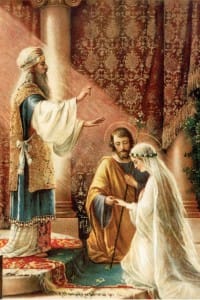Over the past 40 years, the median age of men and women getting married in the US has risen steeply. Catholics, it seems, are no different in this regard. A Pew Research Center study in 2014 found that only 14% of Catholics between the ages of 18-29 were married. Marrying at a much later age has become the “new normal”. Statistics are helpful, but they do not answer the most important question as to whether this is a good thing or not. The answer, not surprisingly, is a resounding “No”.
To see why this question is answered in the negative, we must first make the distinction between what is normal and what is natural. Normality expresses to what degree a man conforms to a cultural norm. These norms are always relative to the culture in which they are established. In the best of all possible worlds, they are also relative to what is natural. It is when the natural and the normal coincide that the behavior in question leads to true flourishing and happiness (in the fullest sense). While it may be normal to get married older, it is questionable whether it conforms to what is natural.
A Natural Time to Get Married?
Marriage in itself is natural for the human person, but the question is whether the nature of marriage itself demands that the spouses wait until they are older to marry. To address this question we must first ask how we determine what is natural.
One way that we can do this is by looking at the biological reality of the human body. What I mean by this can be best illustrated by an example. We know that, despite being deeply immersed in a Freudian-Kinseyan paradigm, children are not sexual beings. If they were, then they would develop sexual capacities before the normal age of puberty (12-16). This is why, as I have written previously, something like Drag Queen Story Hour is an abuse of childhood.
While we might readily admit that biology reveals the grievous nature of sexualizing children, we tend to make a the same error when it comes to marriage and sexual development. Is it reasonable to think that God made men and women sexually mature by their late teens and early 20s only to have them enter a holding pattern for up to a decade? Perhaps you could say yes, except for the fact that they also experience their strongest libido at the same time.

Sexual desire is the strongest desire we experience because it is meant to fuel the courage to make the necessary gift of self necessary for marriage and family life. It is at its strongest at such an early age because it is meant to propel the man and woman out from their parents so as to become parents themselves. The problem is that we now tell young adults that, despite the fact that they experience strong sexual desire, they are too young for marriage. There is the obvious disconnect then between God’s design and lived reality.
With these considerations in mind, it becomes clear that there is something contra-natural about waiting so long to get married. As mentioned, marriage in and of itself at any age is natural so we cannot say it is against nature. It does however tend towards being contrary to the nature of marriage itself, especially because it is the foundation of the Family. Rather than making it possible to be “fruitful and multiply” it contributes to what would more accurately be called the modern “fruitful and maintain” paradigm. Again to be clear, I am not saying there is anything wrong with waiting to marry in individual cases, but in the general trend and attitude towards the later marriages.
Marriage as a Life Accesory
Once we are able to grasp that younger marriages conform with God’s design for marriage, we can begin to ask why many people fail to see this. To say that “Marriage is natural” means that it is one of the things that fulfills our nature (i.e. become virtuous). This fulfillment comes not just because we biologically passed on our genes, but because Marriage and the Family are foundational for our moral growth. The Family is a school of virtue, not just for children, but for the man and woman as both husband and wife and then father and mother.
Our culture, on the other hand, treats marriage as if it is merely an add-on. The professional has taken precedence over the personal. Marriage is not even considered until a certain level of professional success is achieved. The person trains himself to link fulfilment with professional achievement. They also become very set in their ways and their capacity for self-giving in marriage and family is diminished. We should expect the age to continue to increase unless a fundamental shift in attitude occurs. The longer the person waits, the less they are “ready” for marriage.
This putting of the occupational cart before the conjugal horse fails to acknowledge that, as Pope St. John Paul II pointed out, the communion of persons in marriage is a fundamental human good upon which all human goods are built (Veritatis Splendor 14). To add it into an already settled life is to risk disintegration because the true accessories have been placed before the essential. Professional decisions are for the sake of supporting a family. Rather than seeing education and careers as means to supporting a spouse and family, they have become competitors. The attitude is “once I go to school and get a job, then I will think about marriage” rather than “I am choosing to be trained in this profession because it will allow me to take care of my family.” And this attitude is encouraged even by well-meaning Catholics.

